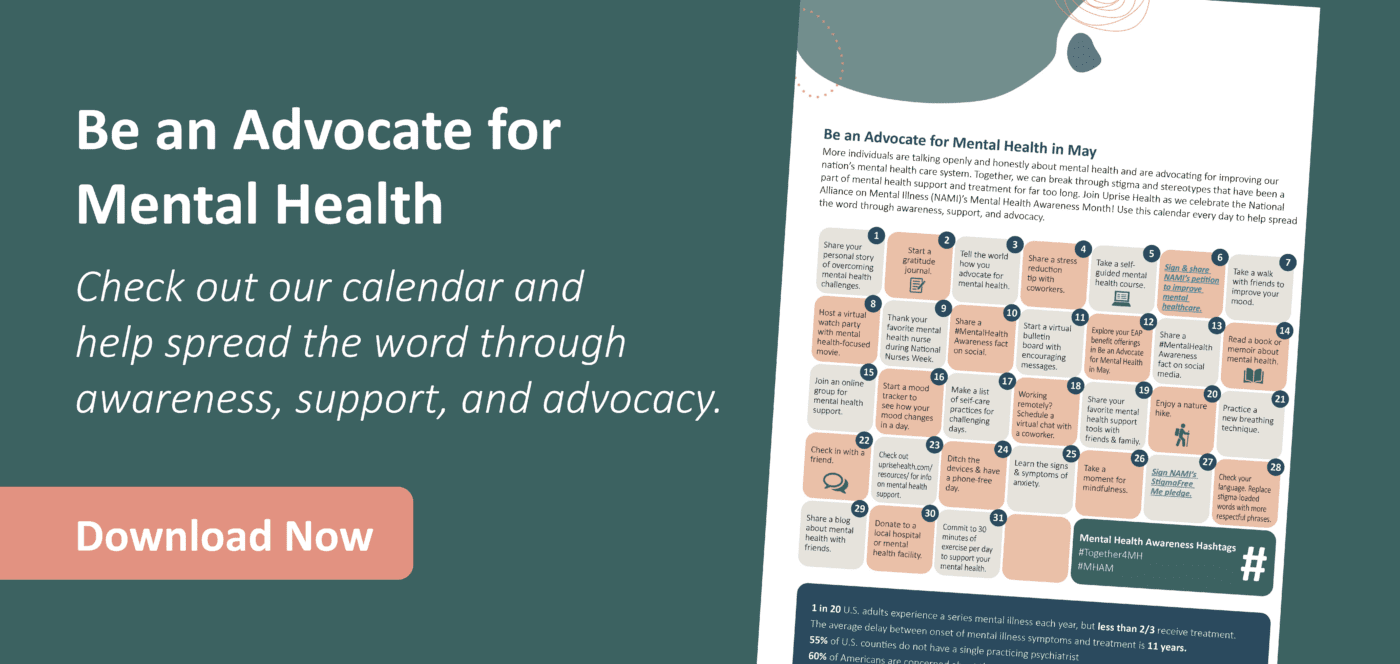A devastating global pandemic, political and social strife in the United States, record-breaking inflation, and geopolitical instability usually are once-in-a-lifetime concerns. Still, in the past few years, significant events have stacked one on top of another and have left employees struggling with anxiety and uncertainty. Many wonder, “What’s next?”
Although the pandemic is currently waning and America is no longer struggling with high unemployment, other ongoing issues, including war in Ukraine and economic repercussions globally as the price of oil grows and inflation continues to climb, are negatively influencing mental health and work-life balance.
During these turbulent times, leaders must support employees through unprecedented times. In our April 2022 leadership webinar, the Uprise Health leadership team weighed in on distinct, actionable steps leaders can take to help employees navigate turbulent times, create a healthier workplace, and thrive. This lively panel discussion featured senior leaders at Uprise Health with decades of experience in the mental health field.
Meet Our Experts
Dr. Christopher Valerian, Chief Medical Officer
Dr. Valerian, a former emergency department physician with years of experience in senior management at various healthcare organizations, serves as Chief Medical Officer at Uprise Health. In this position, he focuses on driving clinical accountability and enhancing the analytics capabilities of the Uprise Health mental health platform.
Melissa Dexter, Chief People Officer
A leader in mental health human resources and digital solutions with more than 25 years of experience in all areas of people operations and human resources, Ms. Dexter helped build Uprise Health’s wellbeing strategy and regularly speaks as an expert on mental health benefits.
Dr. Jay Spence, Chief Product Officer
Dr. Spence is a registered clinical psychologist with a master’s degree in Clinical Psychology and a Ph.D. in Psychology. He’s received multiple awards for research on digital therapeutics and has 19 publications to his name. With his focus on the online delivery of psychology treatment, Dr. Spence has a wealth of knowledge about clinically validated treatment and internet-delivered cognitive behavioral therapy.
In the webinar, our experts shared many takeaways for leaders ready to lead the discussion on mental health in the workplace to better support their employees. Here are three key highlights:
Normalize Mental Health Conversations to Stop the Stigma
For decades, mental health was a taboo topic—with family and friends but especially in the workplace. This attitude started changing during the pandemic. According to an Uprise Health survey, 40% of respondents admitted to an adverse mental health condition triggered by the pandemic.
“For many, the shift to being remote was isolating and compounded their mental health issues during this unprecedented time,” Ms. Dexter shared.
The pandemic brought awareness to symptoms of mental illness and allowed businesses and individuals to view mental health in a new way—freer from the stigma and categorization of those affected by it.
“Instead of lumping mental health conditions in with more serious conditions, like schizophrenia or major depression, they’re looking at it post-pandemic on a continuum of symptoms. We drift up and down on the continuum. It’s helping people become more literate about what mental health means,” Dr. Spence explained.
When employees stay silent about their mental health concerns, it profoundly affects a company’s bottom line: 62% of workdays can be attributed to mental health challenges,1 and mental illness is the most significant cause of worker disability worldwide.1 Normalizing conversations around mental health and providing appropriate evidence-based support will help employees and businesses thrive.
Leadership Involvement is Key
According to Ms. Dexter, one way to prioritize mental health care is to reframe benefits from medical, dental, and vision to medical, dental, vision, and mental health—in other terms, bring care for mental health into the essentials of a benefits package. Ms. Dexter also suggests leaders take a vested interest in mental health support. Leaders should lead with vulnerability, proactively check in with their employees, and create a safe space for employees to speak with frankness and honesty about how they’re feeling.
“The simple question of ‘Are you ok?’ can go a long way,” Ms. Dexter shared.
Dr. Valerian believes simple check-ins where employees can conversationally share how they’re feeling may be enough to alleviate mental health symptoms for a short time. Leaders should regularly be involved in employee engagement to facilitate these types of conversations.
Surveys have found that 62% of employees want their leadership team to talk openly about mental health issues,2 but Dr. Spence believes leaders sometimes shy away from conversations because they aren’t sure what to say. Uprise Health customers and other companies who have traditional EAP programs usually have access to training for leaders to manage mental health conversations effectively.
When leaders are engaged with their employees, they may be able to identify mental health struggles earlier and refer them to EAP offerings that can improve outcomes. An APA study found that just having senior leadership support (with no other changes at all) made mental health interventions more effective.3
Lean into Research for a Healthier Workplace
Leadership support can go a long way in improving mental health conditions, but helping employees start on their treatment path and keeping them on track is the secret sauce for successful outcomes.
Leaders don’t have to recreate the wheel to provide mental health support for employees. We encourage businesses to invest in evidence-based approaches and well-researched best practices with proven results to define what a healthy workplace means and how to encourage it. For instance, the Journal of Occupational and Environmental Medicine published a guide for Organizational Best Practices Supporting Mental Health in the Workplace, developed from peer-reviewed articles to identify eight best practices for workplace health.4 And Policy Research Associates, Inc. published Best Practices for Creating a Mentally Healthy Workplace, which offers a mentally healthy workplace action plan.5
With so many options for mental health information, employees aren’t sure which companies offering digital mental health services are trustworthy. When evaluating EAP solutions or digital products for employee mental health, vet the companies thoroughly to ensure they are using an evidence-based validation approach. Uprise Health is a prime example of using an evidence-based approach to mental health with proven results. Fourteen peer-reviewed publications support Uprise Health’s care protocols by determining participants showed improvement in mood, productivity, sleep, and overall wellbeing. Taking the extra time to find the right EAP and digital product solution will improve results and encourage a healthier workforce.
For more from our experts, watch the full webinar on-demand.
Resources
- https://business.kaiserpermanente.org/insights/mental-health-workplace/stigma-at-work
- https://www.forbes.com/sites/denisebrodey/2019/10/15/62-of-employees-want-leadership-to-speak–openly-about-mental-health/?sh=66a5c49065ac
- https://www.apa.org/news/press/releases/2016/06/workplace-well-being
- https://journals.lww.com/joem/Fulltext/2021/12000/Organizational_Best_Practices_Supporting_Mental.26.aspx
- https://www.prainc.com/wp-content/uploads/2020/01/BestPracticesforCreatingaMentallyHealthyWorkplace508.pdf






